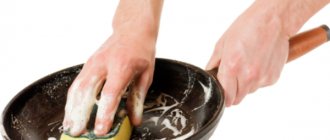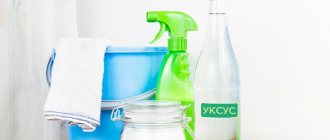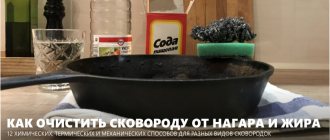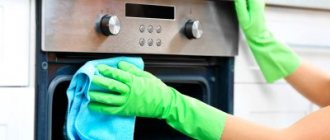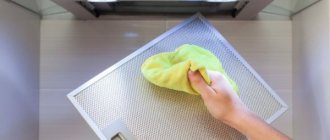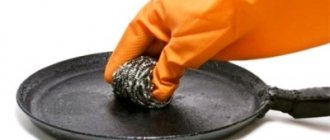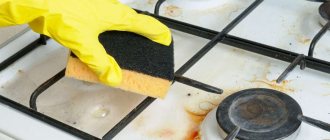After prolonged use, kitchen utensils develop carbon deposits and a coating of fat in which bacteria can accumulate. Soot and deposits deteriorate the appearance of the dishes. Because of them, food begins to burn during cooking and the taste of the cooked dish spoils. Housewives try to solve this problem by soaking dishes in a soapy solution, but this method is ineffective. The expected result can be achieved by using special chemicals and folk remedies.
How to clean dishes from carbon deposits and grease - simple methods
Soaking in water and boiling
The easiest and most affordable way to clean almost all types of dishes from any material is to soak them in water for several hours.
Elevated water temperature and boiling accelerate the process of “softening” the greasy deposits. You can add detergent and repeat the procedure several times, washing off layer by layer. This option will help with fresh or very minor stains. How to clean carbon deposits from an old frying pan? The old layer of fat is unlikely to be removed in this way. Others will do.
Using salt to clean dishes
To clean a frying pan or other utensils from greasy deposits on the inner surface, use regular table salt. The grinding can be anything, be it coarse or fine. Approximately half a glass of salt should be poured into the pan so that it completely covers the bottom. Lightly moisten with water and leave for several hours. The salt will “corrode” the burnt layer, loosen it and it can be easily washed off with a sponge and water. The salt water solution can be boiled in a frying pan or saucepan to speed up the reaction.
Activated carbon
How to clean dishes from grease if salt baths did not help? Try using activated carbon. Crumble it onto the bottom of a frying pan or pan; you can do this by crushing a standard package of tablets in a mortar. Pour some warm clean water and leave it alone for a quarter of an hour. Such a surface-friendly product will cope well with small greasy stains. After removing any remaining charcoal, wash the dishes with detergent and rinse thoroughly. This option is used to remove burnt milk from the bottom of the pan.
Salt with vinegar
To help the saline solution, add vinegar essence. A double hit on the scale should take care of the problem in a few hours. If the apartment is well ventilated and the hood is running, then the vinegar-salt solution can be slightly heated. Be careful, use gloves, and put on a respirator before washing the carbon deposits from the pan.
Onions, apples and lemons
Our grandmothers knew how to remove carbon deposits from a pan using a gentle method. The housewife always has an onion at hand. You need to cut the onion in half, try to moisten the cut and clean off the carbon deposits. Then chop the remaining onions and boil in a small volume of water in a dirty bowl.
By analogy, you can also do the same with an apple. Wipe the burnt areas with a cut, cover the apple skins with water, adding citric (food) acid or lemon juice. The principle of action is an acidic environment formed by malic and citric acids, which corrodes fat. Potatoes cut in half also remove small amounts of fat.
Fortune telling on coffee grounds
Scatter the dried or ground coffee over the bottom of the burnt pan and leave for several hours. Make sure that the coffee does not dry out, add water so that there is a coffee slurry all the time. Rinse off with water and a sponge.
Baking soda with glue and soap
Laundry soap, according to many housewives, is an excellent detergent, its properties far superior to newfangled dishwashing gels and shampoos. Grate a soap bar into coarse shavings, mix with baking soda (pack) and office glue (liquid glass). Add water and boil, stirring until you get a lump-free, homogeneous mass. If you do this in a pan with a burnt bottom, it will be easy to clean.
How to clean the outside of a pan from carbon deposits? In this case, the container should be larger than the dirty pan. It should be completely immersed in the solution and continue boiling. Under the influence of detergent components, the greasy layer, even old ones, softens and can be removed either with a washcloth or, in difficult cases, with a metal brush. If it is not possible to boil the solution, then use it cold; the reaction time will lengthen, perhaps up to a day.
Safe Cleaning Tools
Washing kitchen utensils with a simple sponge to remove old grease is a bad decision. It will take a long time to scrub and without a guarantee of complete success. Hard brushes and abrasive sponges are not suitable for all kitchen materials. And even with them you won’t be able to clean the dishes from stubborn grease. Therefore, any mechanical means should be used only as an aid to the chemical method of removing old fat.
Glass plates can be cleaned under running hot water by rubbing them with crinkled food foil.
An exception is the processing of cast iron cookware. Any abrasives and even iron brushes are appropriate here. They can be used to wipe off plaque and carbon deposits from a cast iron surface.
How to clean a pan from grease
To avoid problems with old grease, it is recommended to soak the dishes immediately after use in warm water with the addition of detergent. Typically, such measures completely prevent troubles in the form of plaque and burning. However, if for some reason the fat still remains on the walls, then you shouldn’t immediately get upset and throw the container in the trash. There are effective ways to clean old grease from pots.
Traditional methods
Perhaps in every home there are ingredients that can easily rid your pans of grease. But few people know that these seemingly simple remedies can cope so effectively with such pollution.
Lemon acid
Citric acid perfectly fights not only scale, but also fat. It breaks down any dirt and returns the dishes shine and cleanliness. To wash the pan from grease, mix 30 grams of lemon juice and 30 grams of soda in a small amount of water until a homogeneous paste forms. Apply the mixture to the walls and leave for 2-3 hours. After some time, you will notice that the fat begins to break down and come off. Rinse off any remaining mixture with clean water and rinse the pan as usual. If it was not possible to achieve a positive result the first time, the procedure can be repeated, increasing the time the mixture is exposed to the contaminants.
Coca Cola
One of the strangest ways to use a sweet carbonated drink, which, nevertheless, has a good result. Few people know that Coca-Cola can even remove rust, let alone grease deposits? All you need to do is fill the dirty container with the drink and leave for 6-12 hours, depending on the intensity of the contamination. Next, you need to rinse the pan in the usual way, and you will immediately notice that there is not a trace of fat left.
Ammonia
When using this method, you should remember that ammonia has a strong chemical odor. For this reason, all cleaning work must be carried out using a respirator and with the windows as open as possible.
Laundry soap
Choose a deep container so that the pan can fit completely into it. Grate a piece of laundry soap there and dissolve the shavings in water. The water should be very cloudy and soapy. Immerse the pan in the solution until the water completely covers it and leave for 3-4 hours. Laundry soap sometimes dissolves grease better than special detergents, but acts a little slower. Then take the pan out and scrub it with the back of a dish sponge. As a rule, after this method, the fat should be completely cleared.
Store products
Special store-bought products that are aimed at removing fat act faster and more effectively than traditional methods. Their only drawback is the presence of aggressive substances in their composition, which can damage the surface of the pan and even cause allergies. Therefore, when purchasing, be sure to read the instructions for use of the product. As a rule, different products are designed for different materials of manufacture. For example, what is suitable for cast iron is strictly prohibited from being applied to enamel or aluminum. Therefore, the first rule when choosing a store-bought product is that it must be designed specifically for the type of material from which your dirty dishes are made. Otherwise, you risk not achieving a good result and even ruining the pan. The most popular and effective universal means for removing fat deposits are:
- AMWAY Oven Cleaner. One of the most effective remedies. In fact, it is designed for cleaning ovens from grease, however, it also perfectly cleans other surfaces, including pots. When using, remember that the product is very aggressive, so the dishes should be rinsed with plenty of water after use.
- Bugs Shumanit. This product is also not designed for cleaning pans, however, it does an excellent job of removing stubborn and burnt fats. Can be used both to prepare a solution and as a detergent.
As you can see, removing old fat from a pan is not that difficult. The main thing is to choose the right cleanser. At the same time, depending on the degree of contamination, even traditional methods can cope with the plaque.
How can you eliminate old greasy plaque?
To quickly clean glassware from grease, including washing off old sunflower oil, it is best to use specialized household chemicals. We list the best store products:
- Fairy;
- Myth;
- Help;
- VOX Drop;
- Synergic;
- AOC.
Experienced housewives also wash cast iron, aluminum, plastic dishes and stainless steel with detergents.
How to clean a cast iron frying pan from years of carbon deposits?
How to clean a cast iron frying pan? Over the years, it has become increasingly difficult to choose and buy such utensils. Old frying pans are the highest quality and most durable. However, they become unusable over time due to grease and soot. Such pans get dirty faster and require special care. How to clean a cast iron frying pan from carbon deposits at home without spending too much on special products? There is always a way out, and your utensils will serve for many years to come.
How to clean a frying pan from grease and carbon deposits at home? You need to grate the soap on a regular coarse grater. Next, you need to take the boiler and fill it with water, at least 5 liters. The diameter of the boil must be large for the pan to fit. After the water boils, pour the soap that you have rubbed into it and pour in the glue. Mix everything well and boil for about fifteen minutes.
How to clean a cast iron frying pan from carbon deposits at home using this method?
- Place the frying pan into the boiling mixture and cook for 15-20 minutes. Water may evaporate, so monitor the amount and add more if necessary.
- Then replace the dirty water with clean, cold water. This will help the pan cool down. The solution will make the dirt very soft, which will allow you to simply peel off the fat from the surface of the utensil.
- Use a regular metal sponge or a knife to clean it completely.
How to clean a frying pan from old carbon deposits? There is another cheap way without using purchased funds. You need to pour a couple of tablespoons of salt into the frying pan and fill it with vinegar. Now put the utensils on the stove and wait for it to boil. After boiling, add a couple of tablespoons of regular soda. You need to cook until all the vinegar has evaporated. Then we rinse the pan well, soot and grease will come off easily.
So that you don’t have to do this often, try to wash the utensils immediately after cooking. It is better to wash the dishes while they are still hot, so they will be washed better.
Coffee paste
Homemade kitchen utensil cleaners are also made from coffee. An unusual composition, but many housewives know about it.
How to cook:
- Take a bar of white soap. It should not contain flavorings. Grate the block on a coarse grater and pour in 250 ml of hot water.
- Add Borax in Glycerin and half a teaspoon of freshly squeezed lemon juice.
- Place the mixture somewhere so that the soap dissolves well. Speed up the process by stirring.
- Add 100 grams of soda to the mixture, and 50 grams of mustard powder and ground coffee (you can buy instant).
- Mix with a blender. The result is a homogeneous cleaning paste.
To soap a plate well, you will need a lot of detergent composition, after all, it is popular. Rinse it off with plenty of water until the soap suds are washed away and there is no squeaking noise.
Folk remedies for cleaning pans from carbon deposits
Above we discussed many recipes on how to clean a pan from carbon deposits at home. If you group them by ingredients, you will get a certain set of rules and recommendations for quickly and efficiently cleaning household utensils.
Salt and baking soda
When combined with baking soda, salt acquires strong cleansing abilities. A quick way to remove heavy stains from food that may have burnt on is as follows:
- Mix baking soda and salt in equal parts;
- Cover the bottom of the dish completely with the mixture;
- Add a few drops of water, mixing with the mixture until you get a porridge;
- Leave it covered for a day;
- Drain the porridge from the mixture and add the same composition, fill it with water and boil for half an hour;
- Drain the liquid, let the dishes cool and wash them with a sponge and dishwashing detergent.
Salt and baking soda have cleansing properties.
Salt
Salt itself is not capable of removing heavy stains, but it can deal with light stains and will also allow for preventive cleaning of dishes:
- Pour fine salt into a wet bowl and wipe the entire surface with it;
- Leave for 3 hours;
- Rinse off the saline solution with a hard sponge.
This advice on how to clean a pan from carbon deposits involves rubbing the surfaces of the dishes with salt, and this cannot be done with enamel objects.
Table salt helps with light stains.
Activated carbon
Charcoal is the easiest way to get rid of burnt milk or other food:
- Crush several tablets into powder;
- Fill the bottom of the dish with coal and leave for 30 minutes;
- Pour in warm water and leave for another hour;
- Use a sponge to remove any remaining charcoal mixture.
Activated carbon helps remove burnt milk.
Soap solution
In case of light, fresh stains, you can use the following recipe:
- Fill the dishes with water and add liquid soap or gel;
- Boil the mixture for half an hour;
- Pour out the contents, cool the dishes and wash them as usual.
Whey will help clean dishes with heavy deposits.
Milk serum
If the dishes have areas with heavy carbon deposits, the acids contained in the whey will help clean the pan. You just need to pour the serum into the dishes, leave for 24 hours, and then wash as usual.
Peroxide and soda
Hydrogen peroxide is another versatile substance that can be used to clean kitchen appliances. It is also used to whiten teeth, clean carpets and remove unpleasant odors.
The best detergent, recipes:
- We wash kitchen utensils with a mixture made from two parts baking soda and 1 part hydrogen peroxide. Used to clean enamel pans.
- A product made from ½ tbsp. l. soda and ¼ tbsp. l. hydrogen peroxide, it turns out thick. We use this mixture to clean the refrigerator, oven and dishes.
This product is also an excellent whitener, but when using these substances, you should wear rubber gloves to avoid damaging the skin of your hands.
Features of washing dishes made from various materials
Glass
It is better to wash glassware in hot water with soft sponges, without using products with small particles: pastes, powders.
To make glass products shine, they need to be washed with the addition of vinegar. To do this you need:
- Make a solution of acid in water at the rate of: 1 tbsp. l. active ingredient per 1 liter.
- Pour the resulting liquid into a large container.
- Immerse the dishes in the solution so that it covers them completely.
- Leave for 15 minutes.
- Wash as usual and dry.
Porcelain
Porcelain products should not be washed with hard brushes or abrasives. To clean hard-to-reach areas, you can use a soft-bristle toothbrush. The water should be at room temperature.
Crystal
It is best to wash crystal glassware with soda; it will remove plaque from the products. Tall glasses, as well as textured surfaces, can be easily washed with a toothbrush or a small laundry brush - the soft bristles will clean out dirt even from the most inaccessible places.
Plastic
Plastic is a rather finicky material. Therefore, you can only wash it with gel and a soft sponge. It is prohibited to use hard sponges, abrasive or aggressive household chemicals, or soda, otherwise the plastic will become covered with unsightly scratches. Products made from this material are also not dishwasher safe.
To clean plastic dishes, you can make a vinegar solution. To do this you need:
- Mix vinegar and water in a ratio of 1:4. For greater effectiveness, you can add 1-2 drops of dishwashing liquid.
- Wipe the plastic with the resulting mixture.
- Soak the container for 50-60 minutes.
- Wash it with normal detergent.
Aluminum
Aluminum is a picky material, but it is not recommended to heat it - it may not withstand high temperatures. Also, do not wash aluminum cookware with abrasive substances, metal sponges or in the dishwasher.
Aluminum can be cleaned with soda or mustard powder. To do this, you need to gently rub the frying pan or pan with the selected product, leave for 20-25 minutes, then wash off the remaining dirt.
Stainless steel
Stainless steel should be washed in water at room temperature, without abrasive substances or hard tools.
For stainless steel cookware, you can use lemon juice. Necessary:
- 2 tbsp. l. dilute the juice with 500 ml of water, mix well.
- Moisten a sponge in the resulting solution and wipe the stainless steel with it.
- Wash with warm water.
- Wipe dry.
Cast iron
You can wash cast iron cookware with aggressive chemicals, hard brushes, sponges, as this is the most picky and durable alloy. Calcining cast iron, for example, to clean a frying pan from carbon deposits, is also allowed.
How to wash old dishes
As cups, bowls and mugs are used, they sooner or later acquire a yellow coating. It occurs for the following reasons:
- tap water contains a lot of metal salts;
- use of low-quality cleaning products;
- hastily washing in low temperature water;
- washing dishes without proper diligence.
You can eliminate yellowness if you use purchased products. It will be even better and cheaper if you use the home remedies listed below to clean the dishes.
- Baking soda solution . Place the dirty dishes in a basin and fill them with hot soda solution (3 tablespoons of solution per 1 liter of water). Soak kitchen items in the liquid for 1 hour. Then rinse them with a sponge under tap water.
- Dry mustard . This product is highly environmentally friendly. Plates, mugs and scoops are placed in a basin with warm water for 50 minutes, after adding 4 tbsp. spoons of dry mustard. Finally, wash the dishes with a sponge.
- Hydrogen peroxide with soda . These components are mixed in equal proportions. After that, apply the composition to the dirty dishes with a sponge and rinse with water. This composition is able to clean any dirt to a shine.
Important!
The use of home remedies allows you to save the family budget. Their prices are low and they are available to everyone. Moreover, they will not harm your health.
Cleaning with special products
Using chemical cleaners, you can deal with carbon deposits on all types of baking sheets, including non-stick ones. The main thing is that the product does not contain caustic alkalis or acids. To reduce the degree of negative impact, use the instructions.
- Use paper towels to remove grease and food residue.
- Apply liquid, gel or powder to the surface and wait 20 minutes.
- If there are dried particles of the dish, soak the baking sheet in warm water.
- Wipe the surface. Aluminum and stainless steel with a sponge, and non-stick and ceramic with a soft sponge.
- Rinse generously with clean water and wipe dry.
Is it difficult to clean a heavily soiled baking tray?
Not really
Using household chemicals, you can wash the baking sheet even from old fat.
How to remove dirt from the back side
If you need to remove greasy deposits from the back of plates or salad bowls, clean them with regular citric acid. To do this you will need:
- slightly moisten the contaminated surface;
- sprinkle it liberally with food additive;
- after fifteen to twenty minutes, rinse with clean water.
Active acid will not only remove dirt, but also return the dishes to their original white color.
General cleaning tips
Let's look at some recommendations that will help housewives keep their dishes clean:
- After each frying of food, it is better to wash the pan immediately, especially the pancake pan. This will help keep the dishes in good condition longer.
- When you wash away carbon deposits, you should not place a hot frying pan under cold water. Temperature changes can damage the coating.
- You can easily wash an enamel frying pan with bleach.
- Stainless steel dishes can be easily washed with salt or soda.
- It is better not to wash the glass lid with powder products. After some time, small scratches will become noticeable.
- The grill pan cannot be washed in the dishwasher, and it is also better to rid it of metal sponges.
- Boiling water in a frying pan with vinegar will help get rid of rust.
- After washing, let the pan dry thoroughly; do not place wet dishes in the kitchen cabinet. Keep pan lids removed.
- Heavily smoked pans can be taken to a professional for cleaning. This is especially true for expensive dishes that you don’t want to ruin.
To prevent fat from appearing - prevention
Having eliminated carbon deposits on a frying pan, you need to take a number of preventive actions to prevent its occurrence in the future.
Start cleaning dishes on both sides immediately after preparing food.
If you usually wash your pans in the dishwasher, then clean them by hand at least once a month. In this case, you will promptly determine the places where the fumes have deposited and can easily eliminate them.
Advice!
Limescale deposits on enamel-coated dishes can be easily removed with a solution containing salt, vinegar and water. It is enough to fill the container with the specified solution for 1 hour.
Try to use cleaning powders, metal sponges and other products that can leave scratches on dishes as rarely as possible. This way you will extend its service life.
Having purchased a new frying pan, be sure to lubricate its inner surface with vegetable oil before using it for the first time. And then wash with detergent and rinse.
Regardless of the material of the cookware, when preparing dishes, use a wooden spatula. The tongs you use should have protection at the ends to protect the dishes from scratches.
Traditional cleaning methods
Not all types of kitchen utensils can withstand cleaning with household chemicals. For example, ceramic or products that have a special coating cannot be cleaned with chemicals. They corrode the coating and the dishes become unusable.
Folk remedies for cleaning dishes are much more gentle and can be applied to any kitchen utensil.
Laundry soap
One of the best means for cleaning frying pans and pots from grease on the inside is laundry soap. To prepare the solution you will need 72% laundry soap and clean water.
The steps for cleaning with soap are as follows:
- Half a soap bar is grated on a coarse grater.
- The shavings are poured into the container that needs to be cleaned and filled with water. It should not reach the edge by about 5 cm. Turn on the heat underneath.
- After the solution boils, reduce the heat and maintain a low simmer for the next half hour.
- Then the stove is turned off, the container is covered with a lid and left until it cools completely.
- Then the solution is drained, and the frying pan or pan is cleaned with a sponge.
This cleaning method does not damage the coating, so it can be used for both ceramic and Teflon cookware.
Vinegar and citric acid
Vinegar combined with citric acid gives excellent results. Prepare the cleaning composition as follows:
- To prepare the solution, a small saucepan is required. A liter of water is poured into it and brought to a boil.
- Then half a glass of 9% vinegar and a tablespoon of citric acid are dissolved in hot water.
- Soak contaminated dishes in a hot solution for 1 hour.
After this procedure, even old fat can be easily cleaned off with a metal or nylon sponge.
An effective dish cleaner
If for a number of reasons you do not have the desire to work with folk remedies for cleaning dishes, then you should resort to one of the options associated with the use of household chemicals. We are talking about using washing powder in combination with dry bleach. According to reviews from many housewives, this composition can return newness to the dishes.
To use this method you need to do the following:
- pour well-heated water into the basin;
- add equal amounts of washing powder and dry bleach;
- mix the composition until smooth;
- place dirty dishes in the solution for 3 hours;
- then wash the items with a sponge and rinse with water.
Rules for cleaning frying pans depending on the material and tips for prevention
Different types of metals and coatings react differently to acids and alkalis, prolonged soaking and heating. When starting to wash your frying pan, find out the contraindications (if you are looking at the table on your smartphone, turn it to a horizontal position - this way the entire table will fit on the screen).
| Cast iron cookware | Teflon cookware | Stainless steel | Aluminum cookware without non-stick coating and enamel | |
| Dishwasher safe | Not possible (the pan will become rusty) | Can | Can | It is forbidden |
| Using abrasive cleaners, brushes, scrapers and hard sponges | Can | It is forbidden | Can | It is forbidden |
| Using baking soda, laundry soap and other alkaline cleaning products | Can | Can | Can | It is forbidden |
| The use of acids (vinegar, citric acid, etc.) | Can | Not allowed (short-term exposure is acceptable) | Can | Not allowed (short-term exposure is acceptable) |
| Long soaking | It is forbidden | Can | Can | Undesirable |
- Aluminum frying pans (without coating) can be washed with cleaning products for glass and porcelain dishes, soap solutions with the addition of ammonia.
- Any dishes should be washed only after they have cooled naturally. If you suddenly transfer a hot frying pan into cool water, it may become deformed. This is especially true for cast iron, aluminum (coated and uncoated) and ceramic frying pans.
- Before soaking or boiling the pan, be sure to remove the wood/plastic handle or simply do not submerge it in water.
What dishes should not be boiled to clean?
Not all dishes can be boiled. Cannot tolerate boiling:
- Aluminum cookware. Under the influence of high temperatures and aggressive chemicals it acquires a dark color.
- Glassware. Boiling is not recommended for several reasons. If the product has microcracks, it may burst. If the dishes are intact and subjected to boiling, an indelible coating remains on the walls, which spoils the appearance.
- Ceramic tableware. When boiling, the coating (glaze) is destroyed, which leads to loss of appearance.
- Plastic dishes. Boiling will simply melt the product, and further use will be impossible.
Note! It is recommended to clean glass, ceramic and plastic dishes with traditional or gentle chemicals to prevent loss of appearance or deformation.
The delicate way
If there is no serious contamination, in order to protect the dishes, it is best to give preference to this gentle method. You will need to stock up on a soft sponge, cleaning product, and warm water.
Wash the pan carefully, without pressing on it. This option is suitable for Teflon and ceramic products - during such cleaning the surface will not be scratched
It is best to give preference to gel. If the dishes are made of silicone, they will be convenient to use - food will not burn, and cleaning the pan will be easy. A mild detergent is suitable for cleaning it.
If the contamination on the Teflon baking sheet is heavy, cleaning will not be done in one stage. Before you clean a baking sheet made of such material from carbon deposits, you need to scrape off any remaining food from the surface, and then sprinkle the dishes with salt. It should be left for 10 minutes for the best effect of the substance. During this time, the salt will absorb the fat. Wash it off very carefully: the substance may leave scratches on the surface.
After moistening a soft sponge in hot water, you will need to drop some gel here, and then wash the dishes. To avoid such cleaning in several stages, it is best to follow the rules for using Teflon cookware.
Melamine sponge
This versatile sponge is ridiculously easy to use.
Universal sponge
Melamine sponge copes with:
- contamination on microwaves, refrigerators and multicookers;
- fat deposits in the oven;
- cleaning burnt fat from stoves, tiles and hoods, kitchen ventilation;
- washing oven grates, barbecues and skewers;
- cleaning rust.
Wet it with water and rub problem areas without using detergents.
Products for silicone and Teflon baking trays
Molds and sheets made of silicone and Teflon were invented to facilitate the cooking process, because if the technology is followed, almost nothing sticks to high-quality cookware. However, over time, a layer of soot will still form, and it can only be removed using gentle methods:
- Soak the silicone or Teflon mold in warm water, adding gel dishwashing detergent. After 30-60 minutes, rinse with clean water and a soft cloth or sponge.
- Clean the Teflon pan from any remaining food and fill the bottom with fine salt. After half an hour, remove the dirty salt and rinse with hot water. If there is carbon residue on the dishes, soak the pan in hot water and liquid detergent.
After washing, be sure to wipe the surface of the sheet or mold dry with a paper or cloth towel to remove any drops that may contain microparticles of fat.
Reasons for the appearance of greasy marks on dishes
A thick layer of old fat cannot be removed by mechanical means alone.
Untidy yellow stains on plates and pans usually accumulate for the following reasons:
- poor cleaning of the entire surface;
- use of low-grade detergents;
- Frequent washing in cold or very hard water.
Pots and dishes that are kept near the cooking area for a long time also become covered with a layer of grease from fumes due to poor ventilation.
On modern frying pans, food will not burn, but on aluminum and cast iron surfaces a thick layer of soot will form.
How to clean a frying pan depending on the material and coating?
Cast iron
This material requires a very careful attitude, because it is very fragile and easily deformed. The following methods will help create the effect of “novelty”:
method one. Sprinkle the bottom with salt so that the dirty bottom from soot is not visible. Next, pour one hundred and fifty grams of nine percent vinegar into the dishes and do not touch the frying pan for half an hour. The next step is to add one hundred grams of soda and boil for fifteen minutes on the stove. All dirt can be removed with a brush, and the surface can be washed with water to remove any greasy shine;
method two. Place the frying pan in a container and fill it with water. Next, rub the soap and put two hundred grams of glue and five hundred grams of soda ash into the liquid. Place on the fire and heat to a boil, and then simmer, waiting for the soot to peel off;
method three. Remove the handle from the pan and place in the oven. Increase the oven heat to two hundred and fifty degrees. Be sure to open the window during processing.
Aluminum
Aluminum frying pans do not accept strong powder compounds for cleaning; it is better to use sprays or gels. It is advisable to clean the dishes after each cooking, because carbon deposits appear on aluminum very quickly. Below are several cleaning methods:
- recipe first. Dissolve three hundred grams of salt in water and boil a frying pan in it for two hours;
- recipe two. Fill the pan completely with sand and heat for two hours or more.
Teflon
Cleaning a Teflon pan is very difficult as the coating on the pan is very easy to ruin, but people have come up with a great cleaning method. Pour water into the frying pan, place on a heated stove and bring the water to a boil. Next, turn off the heat and add two tablespoons of calcined salt and a little dishwashing detergent.
After an hour, the plaque should become softer and can then be washed off with a soft sponge. If possible, boil the pan with clean water one more time.
Ceramic coated
This coating on your pans allows you to cook excellent pancakes and scrambled eggs, so keeping them clean is very important for the taste of your food. There are several proven methods:
- method one. Soot comes off the walls and bottom almost instantly if you wipe the utensil with a cotton pad soaked in alcohol;
- method two. If food burns in the pan, fill it with water and boil for fifteen to thirty minutes. If the carbon deposits do not go away, add a little citric acid.
PVA glue
You can remove grease from old frying pans and ovens using PVA glue. The prepared composition can be used for any material where there are burnt food residues.
How to do:
- You need to boil 4 liters of water.
- Add ⅓ of laundry soap shavings and 1 tbsp to the same container. l. PVA glue.
- Mix the composition. If you need more product, increase all the ingredients, because you will have to boil the pans in this solution.
- Place them in a container and boil for half an hour.
After such a wash, all burnt fat and pieces of food will come off without much effort. You will only need to wash the dishes from any remaining grease with a hard sponge or a steel dish brush (if you can use one).
How to dry properly
If you have a clean container in your hands, the next problem arises - how to dry it. In practice, it turns out that using a hairdryer is unsuccessful.
Glass bottle
The method will require any type of paper, but preferably one that absorbs moisture well. Even kitchen towels will do. A piece of paper is rolled into a tube and placed inside. It is advisable that the end sticks out of the container, as it is needed in order to remove the paper.
Plastic
The container is turned upside down and placed on the surface. It is advisable to place something under the neck. Air should come inside, which will speed up drying.
Household chemicals
Now there are a variety of professional household chemicals that make it very easy to clean frying pans, because they break down old fat more effectively and quickly than traditional methods. You can clean carbon deposits using the following means:
- Cilit Bang Anti-grease. This substance degreases and is suitable for both fresh and very old carbon deposits. Another plus is that Cilit Bang can be found in any hypermarket.
- Gold Unicum removes carbon deposits from dishes without damaging the surface.
- Schumann. This product can be found in almost all stores and supermarkets. It is not cheap, has a pungent odor, and is difficult to wash off, but it also works well with very old fat.
- Mister Muscle. Another affordable, fairly inexpensive substance that copes with many types of contaminants, including carbon deposits.
- Helper Professional. This product is suitable for any coating, even non-stick. It promotes gentle cleaning without scratching the surface with abrasives.
This cleaner is quite difficult to find, but it does its job perfectly: it has virtually no odor, removes even the most stubborn carbon deposits, and is easily removed from the surface.
The pipe cleaner can also be used against old carbon deposits and grease. It acts more aggressively, so you should not test its effect on Teflon and ceramics.
Modern chemicals to combat carbon deposits
In addition to well-known folk methods, special household chemicals are used. Old fat will help to wash off:
- “ Shumanit ” is a strong cleaning agent, but very aggressive. Gloves should be worn when using.
- “ Sanita ” is not as effective as “Shumanit” in removing dirt, but it is inexpensive.
- “Mr. Muscle anti-fat” is a product known from television advertising. Copes well with old carbon deposits.
- Other chemicals that are available in stores are labeled “anti-grease”.
Directions for use: apply to the contaminated surface and leave for 10–20 minutes, after which remove carbon deposits and grease with a regular sponge with an abrasive surface.
Note! On the shelves of supermarkets there are inexpensive products with unknown names: “Every day”, “Red price”. At a low price, they have very good efficiency.
Process steps
Following some rules and an algorithm of actions will help you wash the dishes quickly.
Sorting
The first stage of the washing process is sorting. Its necessity is explained by the fact that cutlery, pots, plates, and cups have varying degrees of contamination. Properly wash dishes in the following order:
- Glasses, mugs, shot glasses, glasses, as they do not come into contact with fat or products with a persistent odor. In this case, soaking is not only possible, but even necessary to skip: the glasses will only become dirtier after lying in the water along with greasy pans and plates.
- Spoons, forks and knives. They also do not require soaking, just wash them with detergent.
- Plates, salad bowls, cutting boards. The latter should be additionally wiped with vinegar if they cut fish or meat. This will disinfect the surface.
- Pots, pans, cauldrons, ladles, baking dishes. They definitely need soaking, otherwise it will be very difficult to remove fat and carbon deposits.
Soak
To quickly wash dishes by hand, you should first soak them. This will soften the stuck-on contaminants, making it much easier to wash them off.
Large food particles must be removed before soaking. Then place the dishes in a large container with hot or very warm water - it can be a basin, a bucket. You can also use a sink, after plugging the drain with a stopper. It is better to add a couple of drops of detergent to the water - this will make soaking more effective. After 20-30 minutes, drain the water and begin the main procedure.
The washing up
After sorting the dishes and soaking the necessary items, you can proceed directly to washing.
The algorithm is as follows:
- Apply 1-2 drops of detergent to the sponge.
- Squeeze the product in your hands several times until foam appears.
- Wash the plate, cutlery or pan from all sides, carefully scrubbing off any remaining food.
- If necessary, use a metal sponge or a stiff brush to remove stubborn dirt.
- Rinse the product thoroughly under running warm water, preferably several times. If the water is cold, the fat will be washed off less easily.
Drying
After washing, you can immediately put the dishes in the dryer, where excess moisture will drain from them. It is not necessary to wipe the devices with a towel or dry cloth. Moreover, scientists have proven that a towel is a favorable environment for the growth of bacteria, some of which can cause poisoning if they get on plates or cups.
But glasses, mugs, shot glasses, and jugs should still be wiped, as water leaves stains on them that spoil their beautiful appearance. Therefore, the best solution would be to wipe only transparent products. To prevent bacteria from growing on the towel, you need to dry it and change it every 7 days.
